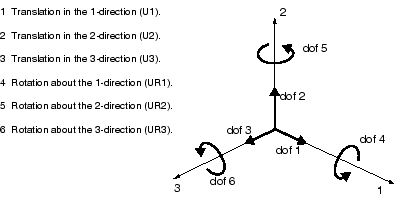Context:
In this model the bottom-left portion of the frame is constrained completely and, thus, cannot move in any direction. The bottom-right portion of the frame, however, is fixed in the vertical direction but is free to move in the horizontal direction. The directions in which motion is possible are called degrees of freedom (dof).
The labeling convention used for the displacement and rotational degrees of freedom in Abaqus is shown in Figure 1.
Figure 1. Displacement and rotational degrees of freedom.

In this example all the constraints are in the global 1- or 2-directions. In many cases constraints are required in directions that are not aligned with the global directions. In such cases you can define a local coordinate system for boundary condition application. The skew plate example in Using Shell Elements, demonstrates how to do this.
In the Model Tree, double-click the BCs container.
Abaqus/CAE switches to the Load module, and the Create Boundary Condition dialog box appears.
In the Create Boundary Condition dialog box:
- Name the boundary condition Fixed.
- From the list of steps, select Initial as the step in which the boundary condition will be activated. All the mechanical boundary conditions specified in the Initial step must have zero magnitudes. This condition is enforced automatically by Abaqus/CAE.
- In the Category list, accept Mechanical as the default category selection.
- In the Types for Selected Step list, select Displacement/Rotation, and click Continue.
Abaqus/CAE displays prompts in the prompt area to guide you through the procedure. For example, you are asked to select the region to which the boundary condition will be applied.
To apply a prescribed condition to a region, you can either select the region directly in the viewport or apply the condition to an existing set (a set is a named region of a model). Sets are a convenient tool that can be used to manage large complicated models. In this simple model you will not make use of sets.
In the viewport, select the vertex at the bottom-left corner of the frame as the region to which the boundary condition will be applied. Name the associated set left.
Click mouse button 2 in the viewport or click Done in the prompt area to indicate that you have finished selecting regions.
The Edit Boundary Condition dialog box appears. When you are defining a boundary condition in the initial step, all available degrees of freedom are unconstrained by default.
In the dialog box:
- Toggle on U1 and U2 since all translational degrees of freedom need to be constrained.
- Click OK to create the boundary condition and to close the dialog box.
Abaqus/CAE displays two arrowheads at the vertex to indicate the constrained degrees of freedom.
Repeat the above procedure to constrain degree of freedom U2 at the vertex at the bottom-right corner of the frame. Name this boundary condition Roller and the associated set right.
In the Model Tree, click mouse button 3 on the BCs container and select Manager from the menu that appears.
Abaqus/CAE displays the Boundary Condition Manager. The manager indicates that the boundary conditions are Created (activated) in the initial step and are Propagated from base state (continue to be active) in the analysis step Apply load.
Click Dismiss to close the Boundary Condition Manager.
